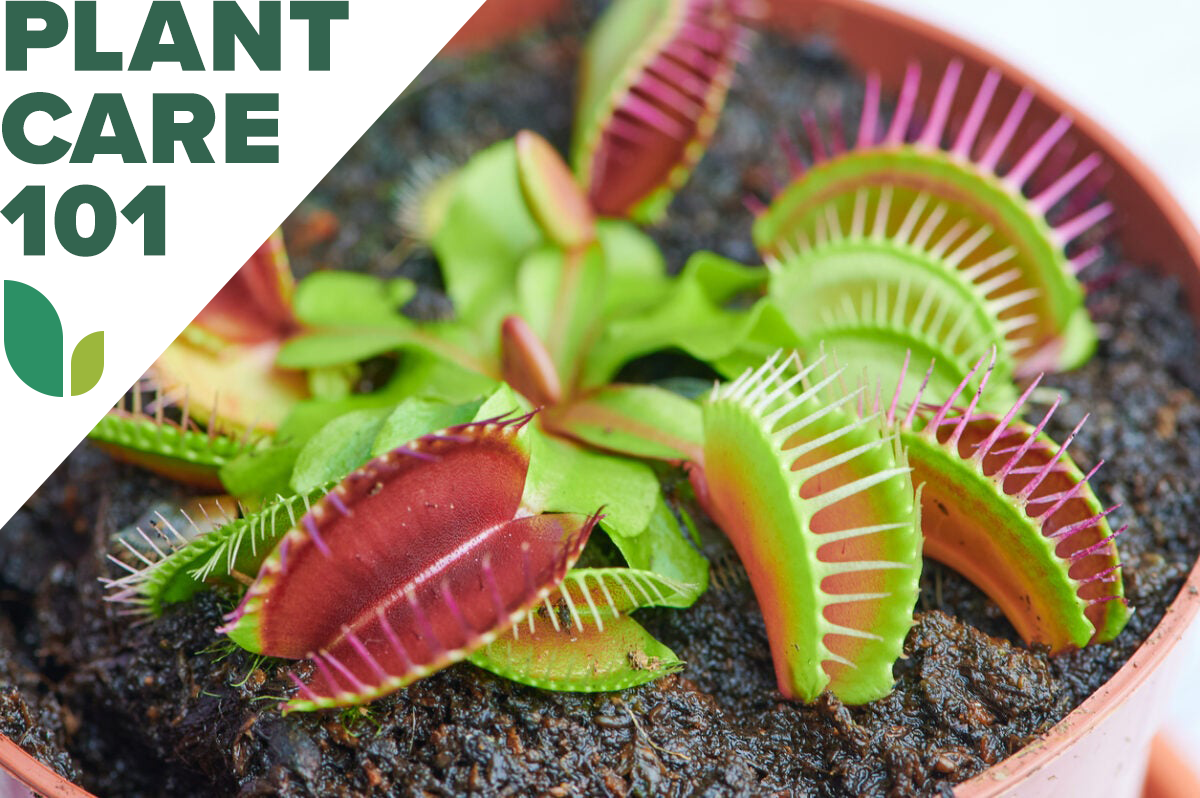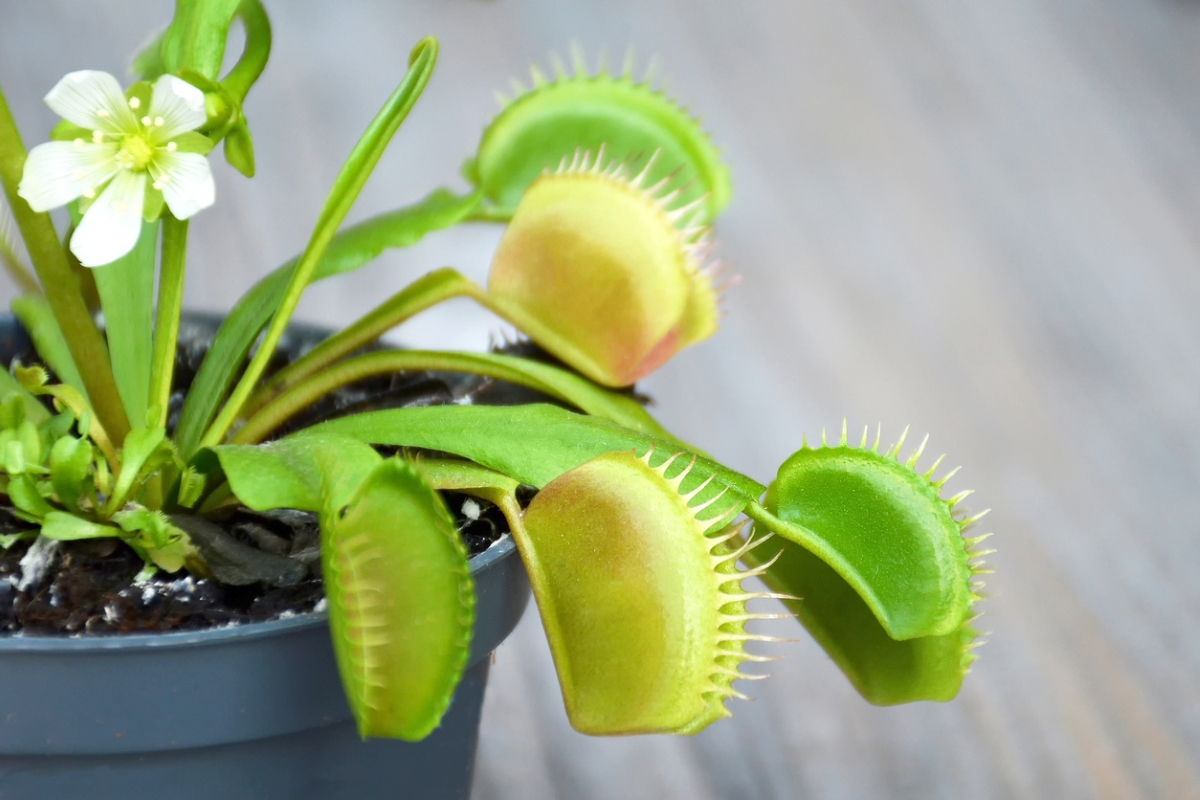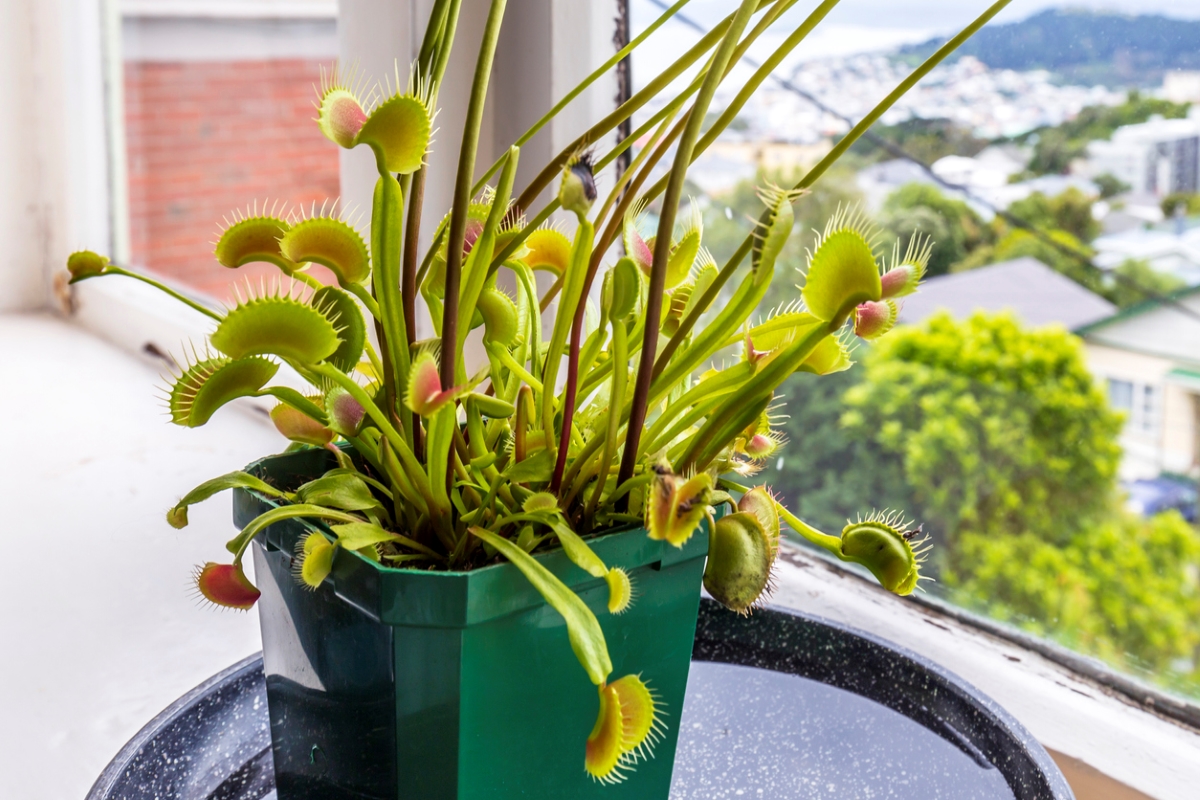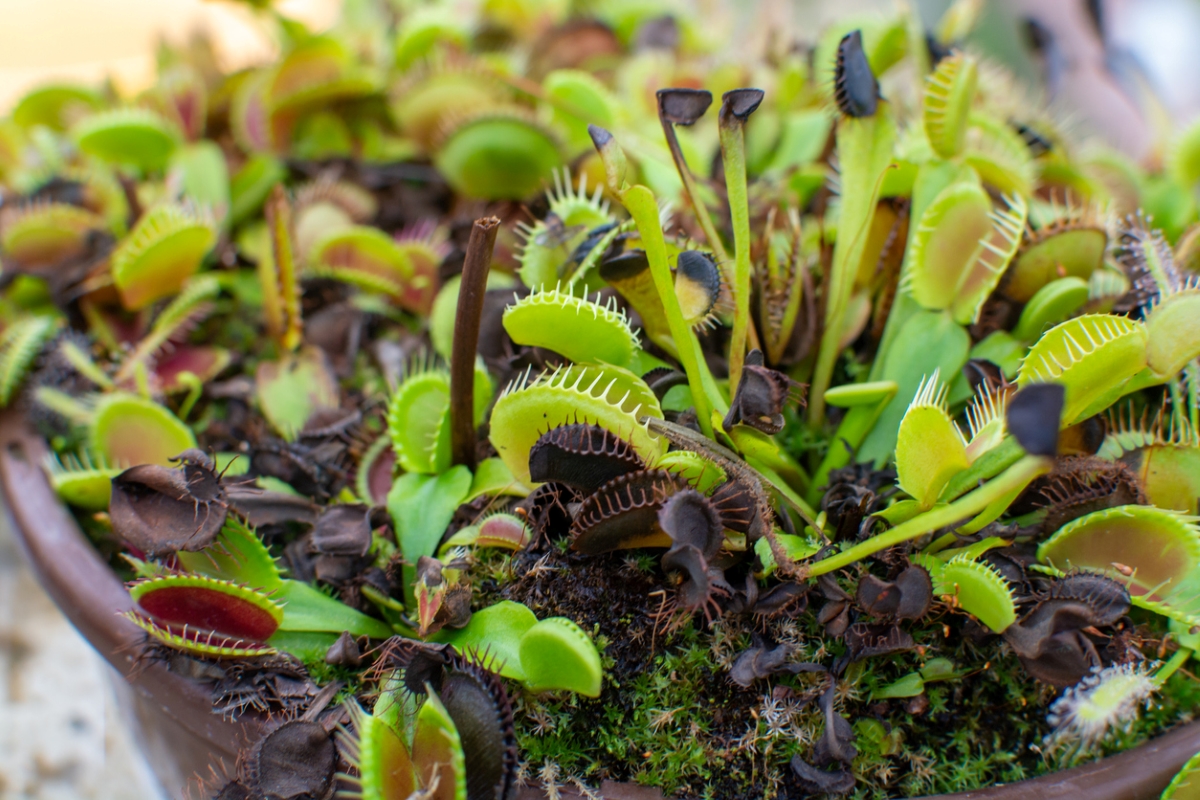

We may earn revenue from the products available on this page and participate in affiliate programs. Learn More ›
It’s almost impossible to not be fascinated by a plant that gets most of its nutrients by actively luring and trapping prey. Though the Venus flytrap’s hunting abilities make this houseplant sound a little creepy, it remains a popular potted plant around the world.
Venus flytrap plants are easy to grow, but they can be difficult to keep healthy and alive, giving them a reputation as somewhat onerous divas. But, just like any other houseplant, they just need the right conditions to grow their best. This Venus flytrap care guide will arm growers with the knowledge they need to help their little carnivores last a long time.
RELATED: 34 Amazing Plants That Are Native to North America
Venus Flytrap Care at a Glance
Common Name: Venus flytrap
Scientific Name: Dionaea muscipula
Soil: Poor, acidic soil; pH 4 to 4.5
Light: Full sunlight
Water: Bottom-watering
Food: Insects
Temperature and Humidity: High humidity
Propagation: Seeds, rhizomes, or cuttings
Safety: Nontoxic
Venus Flytrap Characteristics

The Venus flytrap, or Dionaea muscipula, is a deciduous perennial plant endemic to North and South Carolina. D. muscipula is related to sundews, placing it in the Droseraceae plant family. Venus flytrap plants usually have light-green leaves and green or deep-red lobes. Typically in May and June, Venus flytrap flower stalks appear and grow up to 12 inches tall, with small white flowers blooming high above the rest of the plant.
Venus flytraps are famous for their hinged lobes at the end of each leaf that resemble a mouth and sharp teeth. The Venus flytrap plant secretes a nectar that attracts insects and patiently waits until they show up. When an insect comes into contact with the plant’s trichomes (hair-like projections on the inner surfaces of the lobes), the “jaws” of the Venus flytrap close, locking the prey inside. The plant’s glands then secrete an enzyme that aids digestion.
Proper Venus flytrap care can see these plants live for 20 years or more. Thankfully, it’s a slow grower, so it likely won’t outgrow its pot until it starts reproducing. Though grown as a houseplant in many places across the globe, the Venus flytrap is considered a vulnerable species in decline.
Types of Venus Flytraps
The Venus flytrap is the only plant in its species, but horticulturalists have developed several cultivars of the plant, including:
- Akai Ryu: Also known as the ‘Red Dragon’ Venus flytrap, this variety’s leaves, petioles, and traps are a deep maroon or burgundy in color.
- Justina Davis: This Venus flytrap plant is rare and entirely bright-green, and it remains that hue, even in full sun.
- B52: Considered the largest Venus flytrap, this type produces a high number of traps, which are often more than 2 inches long.
- Clayton’s Red Sunset: The outside of this variety’s traps have a gradient from deep red to green, and it has somewhat thinner leaves than other types.
- Bohemian Garnet: Another all-red Venus flytrap, this one is half the size of most members of the species.
Selecting Soil for Venus Flytraps
Venus flytrap plants naturally grow in moist, nutrient-poor soil with a pH around 4.0 or 4.5. Though this carnivorous plant gets some nutrients from the soil, it gains the rest through photosynthesis and supplements its “diet” by eating insects and arachnids.
For the best indoor Venus flytrap soil, a mix containing sphagnum or peat moss and sand is a typical recommendation. A standard carnivorous plant soil like this highly rated option available at Amazon is one part peat moss to one part perlite. Instead of perlite, many gardeners opt for silica or horticultural sand instead. Avoid putting a Venus flytrap in regular potting soil, however, as it can burn the plant’s roots and kill it relatively quickly.
Because the plant grows fairly slowly, you only need to repot a Venus flytrap with some new soil mix every few years.
The Right Light

When it comes to Venus flytrap care, many people are challenged by the plant’s lighting requirements. A Venus flytrap likes full and direct sunlight, and providing the right type and amount of light is vital when it comes to keeping this plant healthy. In general, give the plant at least 6 hours of direct sunlight per day from a southern exposure. During the active growing season (late winter through early fall), try to provide it with 12 hours of light each day.
Venus flytrap owners should be aware of how seasonal shifts affect this species. In the heat of summer, Venus flytrap plants may be fine with only 2 hours of sunshine. If they’re left in a hot window too long, it can cause them to wilt. If these signs appear in your Venus flytrap, reduce the amount of direct light it receives.
In low-light months, or in homes lacking sufficient sunlight, supplement it with artificial light. Use fluorescent lights labeled “cool white” or “cool blue” for plant growth; meanwhile, you can use bulbs of a warmer color to help with flower growth. Position the bulbs within 8 inches of the Venus flytrap to ensure it gets enough light to remain healthy.
Watering Venus Flytraps
Venus flytraps like environments that mimic their natural wetland habitat. The soil should be kept moist, but not soggy. The bottom watering method is key to achieving the right moisture balance.
These plants need to be in a container with a drainage hole in the bottom, and the container should be placed in a dish with approximately ½ to 1 inch of water. This dish should never dry out, so add water often to keep the dish topped up. Venus flytrap should be given at least a 2-inch margin between the dish’s water level and the top of the soil in the pot. Transplant the plant to a taller pot, if needed.
Venus flytraps are sensitive to some types of water. Be sure to use distilled water, rainwater, or reverse-osmosis water. Using tap, bottled, or filtered water is discouraged, as these tend to contain levels of dissolved salt that can kill the plant.
Outdoor Venus flytraps might grow in containers that fill with rain. That’s okay; these plants can survive living underwater for months—it won’t hurt them, but growth will be inhibited while they’re underwater.
RELATED: 12 Plants You Can Grow Successfully in the Shower
Fertilizing Venus Flytraps

Unlike many other houseplants, a Venus flytrap requires no fertilizer. Natural Venus flytrap soil is low in nutrients, creating an environment that causes the plant to adapt how it feeds. Nutrient-rich fertilizer will only cause the plant to slowly die.
Instead, this carnivorous plant should feed on live prey. Every week or two during the growing season, it should consume a live insect no bigger than ⅓ the size of the trap. These plants can survive without eating bugs, but they won’t be very healthy.
Outdoor plants can catch enough to eat, but indoor Venus flytrap owners need to help their houseplants acquire food. Many pet stores sell live mealworms or crickets, which growers can place into the traps using tweezers. It takes 3 to 5 days for the plant to digest an insect.
A Venus flytrap plant should only be fed insects. Giving it pieces of human food can cause indigestion and bacterial rot—which can kill the trap, if not the entire plant.
Setting the Temperature and Humidity
Venus flytraps kept indoors should be kept in the 65- to 75-degree Fahrenheit range during most of the year. To keep a Venus flytrap plant healthy and growing each year, it needs approximately 10 weeks of dormancy, usually sometime between Thanksgiving and Valentine’s Day.
During Venus flytrap dormancy, the plant can live in temperatures as low as 40 degrees Fahrenheit. If temperatures get lower than this, owners might need to move the plant or cover it up at night to retain heat and moisture. The plant may look like it’s dying because the Venus flytrap turns black, but it will reawaken in spring.
These carnivorous plants love humidity, preferring environments of greater than 50 percent humidity. Bottom-watered plants do not require any extra misting to generate humidity. In drier homes, the water dish might empty frequently, reducing the humidity in the pot. Be sure to keep ½ to 1 inch of water in the dish to avoid this.
Propagating Venus Flytraps

Currently, Venus flytrap plants are threatened by overcollection, habitat destruction, and fire suppression, and are listed as a vulnerable species internationally. This makes propagation especially important, and there are three methods for how to propagate Venus flytraps.
Venus flytrap flowers appear on a tall stalk high above the traps, preventing pollinating insects from becoming food. These flowers can produce dozens of very tiny, shiny black seeds. Any Venus flytrap seeds can be planted immediately or stored in the refrigerator. Any resulting seedlings take several years to mature.
This plant also reproduces via its rhizome. Venus flytraps never have more than seven leaves. If a plant appears to have more than seven leaves, it is a sign that another plant already has formed from the mother plant’s rhizome. Gently use your hands to pry them apart and replant them.
Finally, in early summer, leaf cuttings can be taken. Peel the leaves from the rhizome and place them in a carnivorous plant soil mix, covering the cuttings with a plastic bag to promote humidity. This process takes about 2 years for the cutting to become a mature plant.
Safety Considerations
Though it may look menacing, the Venus flytrap plant is harmless to people and pets. Even the 2-inch traps on the D. muscipula ‘B52’ cannot hurt people, and they are certainly not strong enough to prevent even a child from pulling away from the traps’ jaws. Just because it looks like it has teeth, doesn’t mean it bites. Should a child or pet consume part of the Venus flytrap, it’s not toxic. The worst-case scenario would be a mild upset stomach.
Frankly, kids and pets are more likely to harm a Venus flytrap than the other way around. It’s best to place these pots out of reach of little fingers and wagging tails, making this houseplant perfect for the kitchen or a hanging basket. Kids might find it entertaining to tease the hairs of the traps and watch them shut tightly. After this happens too many times in a row (usually seven or more), the trap will lose its ability to open. It’s best to involve curious kids in feeding insects to the plant to avoid this fate while educating them in the process.
Potential Pests and Diseases

After a few months, and a few meals, it’s natural for the lobes of the Venus flytraps to turn black and die. This isn’t anything to worry about! Once the lobes turn completely black, cut them off with sanitized shears or scissors so new lobes can replace them. Though black leaves generally are not an issue for these plants, there are a few problems that can affect them.
Two pests to watch out for are aphids and fungus gnat larvae. Aphids can escape from the Venus flytrap thanks to their small size, giving them full reign to cause damage. Meanwhile, fungus gnat larvae can burrow into Venus flytrap stems and feed on their leaves.
Fortunately, Venus flytraps are not particularly vulnerable to many fungal or bacterial diseases. One potential problem, however, is gray mold, which forms when dead leaves and debris build up, or if the plant doesn’t receive enough light, warmth, or air circulation.
If a plant seems otherwise sickly, it’s likely not getting enough light. Increase the amount of sunlight or artificial light it gets to nurse it back to health.
RELATED: 10 Endangered Plants You Can Help Save at Home
FAQs About Venus Flytrap Care
Venus flytraps require diligent care, and that naturally leads to an abundance of questions owners may have. Below are a few of the most frequently asked questions and answers about Venus flytraps to help plant lovers decide if this is a plant that belongs in their home and how to keep it healthy.
Q. How often should you feed a Venus flytrap?
In the growing season, feed a Venus flytrap one insect every week or two. The rest of the year, it can go months between feedings.
Q. Are Venus flytraps poisonous to cats or dogs?
Venus flytrap plants are not poisonous to cats, dogs, or people.
Q. Do Venus flytraps only eat insects?
Allowing a Venus flytrap to eat only insects is the healthiest choice for the plant. Other types of food take too long to digest and can cause bacterial rot and other issues.
Looking for more nontoxic plants? Check out our guides on caring for hoya plants, zebra plants, and air plants.
